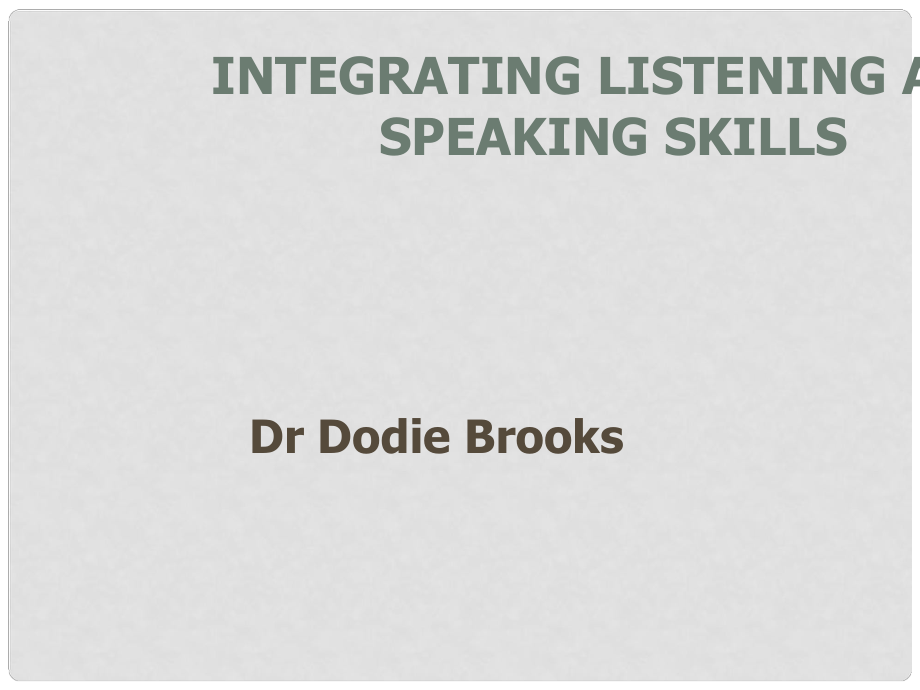《湖南省師范大學(xué)附屬中學(xué)高中英語 Teaching listening skills through NSEC課件》由會(huì)員分享���,可在線閱讀�����,更多相關(guān)《湖南省師范大學(xué)附屬中學(xué)高中英語 Teaching listening skills through NSEC課件(33頁珍藏版)》請(qǐng)?jiān)谘b配圖網(wǎng)上搜索���。
1、INTEGRATING LISTENING AND SPEAKING SKILLS Dr Dodie BrooksVALUE OF LISTENING SPEAKINGextends issues develops logic and creativitydevelops autonomy + co-operative and collaborative work attitudesdevelops the planning skills necessary for good writing PROCESS OF TEACHING LISTENING SKILLS1 Pre-Listening
2�����、: prediction2 *Initial Listening: voice + accent3 L1: main idea4 L2: for organisation of argument, information or story5 L3: for details6 L4: for reinforcement* If necessaryANALYSIS OF EXAMPLESPre-ListeningWhile listening Post-ListeningPre-ListeningSkill 1: predict content ListeningSkill 2: main ide
3��、aSkill 3: for detailsPart A: exercises (analyse) + questions (predict);Part B: exercises + questions Post-Listening(speaking)1 task2 discussion 3 personal comment: Do you agree?PRE-LISTENING1 Setting the scene (U1 p.14)2 Imagine your feelings if (U4 p.31)3 Discuss a question (U.5 p.38)4 Predict cont
4、ent (U3 p.23) LISTENING PROCESS How many times?as many as necessaryHow many parts?1 or 2 parts: 100 words 2 partsPROBLEMS IN LISTENING 11 clustering: Ss may try to remember too much2 redundancy: ignoring the repetitions, time to think, etc3 reduced forms: contractions (Ill) or words run together (Dj
5����、eetyet?) or omitting words (Mum! phone!)PROBLEMS IN LISTENING 2STRESS AND INTONATION Why did you buy a new car?(We cannot afford it)Why did you buy a new car?(and not rent one)Why did you buy a new car?(You could have bought a secondhand one)LISTENING FOR THE MAIN IDEAto show understandingto provide
6�����、 a context help with problem of stress and intonation LISTENING ACTIVITIES Hierarchy for showing understanding:Hierarchy for showing understanding:answering true/false statements (literal/inference)general questions (ideas)note taking (redundancy)using information task or discussion (extension)TAKIN
7�����、G NOTES1 to avoid redundancy2 to listen for detailed information3 to use information to answer another question or do a taskEXAMPLESPOST-LISTENING SPEAKING After listening: EITHERgive own opinionorextend the topic - integrated activity or taskSPEAKING SKILLS1 Provide a context: open-ended question o
8���、r extension task2 Process: (1) 2s another pair = 4s (2) negotiate best idea3 Content: issue to discuss no right or wrong answer open-ended4 Post-speaking: share ideasORGANISING SPEAKING ACTIVITIES2-steps (1) pairs (2) fours most efficient for oral practicelearn to negotiate opinionsarrive at a conse
9����、nsusTEACHERS ROLE provide context for issue keep students on task act as a resource and encourage make observations on future learning ask Ss with interesting ideas to report back to the classDISCUSSION: JUSTIFYING CHOICES: M1 U3 WBImagine you are preparing foryour own trip down the Mekong.Look at t
10�、his list of items. Whichfive would you take?flashlight radio flask umbrella blanket compass raincoat matches can opener tent mapDISCUSSION: MORAL EDUCATIONM2 WB EX.2 P.45 Your best friend tells you that he / she has stolen somethingsmall from a shop. He / Shethinks it is funny that he / shegot away
11��、with it. What will yousay to him / her?TASK: DEVELOPING EMPATHY M1 U1 SBImagine you have to go intohiding like Anne and herfamily. What would youmiss? Give your reasons.EVALUATING SPEAKINGTwo aspects:organisation (first, second, third )ideas + reasons givenEVALUATING ORGANISATIONshould have a clear
12�、structureIntroduction: set out main ideasMiddle: develop ideas fullyEnd: repeat summary of main ideasOrFirst Second Third EVALUATING IDEASDid the studentsset out their ideas clearly?give their reasons?give examples?OVERALL CRITERIAHighExamines more than one ideaWell organisedInterestingLowExamines onlyone ideaPoor organisationNot interestingLIMITATION OF LISTENING AND SPEAKINGconclusions not permanent THANK YOU FOR LISTENINGAny suggestions or questions to:dodie2000ukyahoo.co.uk
 湖南省師范大學(xué)附屬中學(xué)高中英語 Teaching listening skills through NSEC課件
湖南省師范大學(xué)附屬中學(xué)高中英語 Teaching listening skills through NSEC課件

